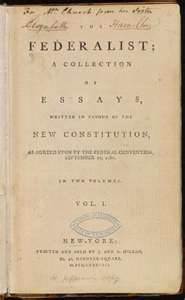Part 1: Defense of the New Form of Government
The Federalist Papers, a group of 85 essays promoting the ratification of the Constitution, appeared in New York newspapers in 1787 and 1788. Taken together, the essays form a powerful defense of the new theory of government that for a time hung in the balance. The Constitutional Convention produced its final draft of the Constitution and submitted it to the 13 Colonies for approval in September, 1787. The Constitution itself stipulated that in order to become law, the new framework of government had to gain the approval of nine of the 13 Colonies. New York, as a colony with one of the largest populations, had considerable influence. Some states quickly ratified the Constitution; other states were more deliberate in their consideration.
In response, Hamilton and Jay, along with James Madison (who, unlike Hamilton and Jay, was from Virginia, not New York), chose the name "Publius," after a Roman aristocrat who led the overthrow of the Roman monarchy in 509 B.C. Delaware became the first state to ratify the Constitution, on December 7, 1787. Pennsylvania and New Jersey followed later that month. Georgia and Connecticut ratified in January, 1788. Massachusetts followed the following month, with Maryland (April) and South Carolina (May) also ratifying later that year. When New Hampshire ratified, on June 21, 1788, the Constitution was declared in effect. Virginia voted for ratification in June, and New York did the same the following month. North Carolina, in 1789, and Rhode Island, in 1790, became the last of the 13 Colonies to vote for ratification. At the time of the publication of The Federalist No. 1, on October 27, 1787, no states had voted for ratification. Hamilton and other Federalists wanted New York to voice its approval because the colony had one of the largest populations in the 13 Colonies. So issues of The Federalist began appearing, along with more of the "Cato" and "Brutus" letters. For the better part of the next year, more essays of The Federalist, each one arguing in favor of the Constitution and some its components or ideas. Hamilton wrote 51 of the 85 essays. Jay wrote just a few, writing four of the first five but then falling ill and writing just one more. Madison wrote the rest, including several in collaboration with Hamilton.
Each essay began the same way, "To the People of the State of New York," and ended the same way, signed "Publius." The identity of "Publius" was not a complete secret. Many in New York and elsewhere knew that Hamilton, Jay, and Madison were behind the efforts of The Federalist. An 1802 book version named the authors for the first time. At times through the years since the essays first appeared and throughout the publication of subsequent editions, disputes over authorship have arisen. Historians have generally agreed on all of Jay's essays and most of the others. Both Hamilton and Madison claimed authorship of a few, and some scholars still disagree on the extent to which either or both contributed to specific essays. The essays that make up The Federalist (as it was called until the 20th Century, when scholars beginning adding the word "Papers") generally had one central theme each, although some themes carried over into multiple essays. In the first essay, Hamilton laid out the six topics that would be covered: 1. "The utility of the UNION to your political prosperity" Essays 2–14 covered the first topic. Essays 15–22 covered the second topic. The third topic featured in essays 23–36. Numbers 37–84 covered the fourth topic. It was left to the final essay to cover the final two topics. |
|
Social Studies for Kids
copyright 2002–2025
David White

 Federalists like
Federalists like  The Federalist appeared regularly, as many as four times a week, for the better part of the next year in three newspapers, the Daily Advertiser, the Independent Journal, and the New-York Packet. In all, 77 of the 85 were published in newspapers; the others were published in a two-volume book form, in late 1788. The essays were also published in other colonies, in both newspapers and book form. (A French edition was published in 1792.)
The Federalist appeared regularly, as many as four times a week, for the better part of the next year in three newspapers, the Daily Advertiser, the Independent Journal, and the New-York Packet. In all, 77 of the 85 were published in newspapers; the others were published in a two-volume book form, in late 1788. The essays were also published in other colonies, in both newspapers and book form. (A French edition was published in 1792.)
